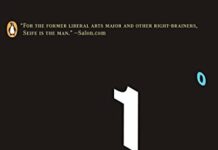
Ebook Info
- Published: 2010
- Number of pages: 304 pages
- Format: PDF
- File Size: 1.84 MB
- Authors: Charles Seife
Description
The bestselling author of Zero shows how mathematical misinformation pervades-and shapes-our daily lives. According to MSNBC, having a child makes you stupid. You actually lose IQ points. Good Morning America has announced that natural blondes will be extinct within two hundred years. Pundits estimated that there were more than a million demonstrators at a tea party rally in Washington, D.C., even though roughly sixty thousand were there. Numbers have peculiar powers-they can disarm skeptics, befuddle journalists, and hoodwink the public into believing almost anything. “Proofiness,” as Charles Seife explains in this eye-opening book, is the art of using pure mathematics for impure ends, and he reminds readers that bad mathematics has a dark side. It is used to bring down beloved government officials and to appoint undeserving ones (both Democratic and Republican), to convict the innocent and acquit the guilty, to ruin our economy, and to fix the outcomes of future elections. This penetrating look at the intersection of math and society will appeal to readers of Freakonomics and the books of Malcolm Gladwell.
User’s Reviews
Editorial Reviews: From Booklist *Starred Review* Following in the footsteps of John Allen Paulos (Innumeracy, 1989) and Michael Shermer (Why People Believe Weird Things, 1997), Seife conducts a thorough investigation into why so many of us find it so easy to believe things that are patently ridiculous. Why, for example, does anyone take seriously the idea that some vaccines can cause autism, or that athletes who wear red have a competitive advantage? It’s all comes down to numbers, the author argues, and the ways they can be used to make people believe things that are not true. He introduces us to the concepts of Potemkin numbers (deliberately deceptive statistics), “disestimation” (turning a number into a falsehood by taking it too literally), fruit-packing (a variety of deceptive techniques including cherry-picking data and comparing apples to oranges), and “randumbness” (finding causality in random events). He explores the many ways we misunderstand simple mathematical terms—confusing average, for example, with typical—and our natural tendency to treat numbers as truth and to see patterns where none exist. Despite its serious and frequently complex subject, the book is written in a light, often humorous tone (the title is a riff on Stephen Colbert’s “truthiness,” although proofiness has been in circulation for a while, with a variety of meanings). A delightful and remarkably revealing book that should be required reading for . . . well, for everyone. –David Pitt Review “… passionate … This is more than a math book; it’s an eye-opening civics lesson.” -The New York Times Book Review “Seife’s book is an admirable salvo against quantitative bamboozlement by the media and the government.” -Boston Globe “Seife’s coinages, humor, and curious tidbits keep readers engaged as the book gradually moves from a description of techniques to their practical application.” -Philadelphia Inquirer “If Stephen Colbert had had time to write a math book, he surely would have written Proofiness.” -Dallas Morning News “Sprightly written, despite its sobering message.” -Kirkus Reviews “A delightful and remarkably revealing book that should be required reading for . . . well, for everyone.” -Booklist (Starred review) About the Author Charles Seife is the author of Sun in a Bottle and Zero, which won the PEN/Martha Albrand Award for first nonfiction book, and was named a New York Times Notable Book. He has written for Science Magazine, New Scientist, Scientific American, The Economist, and Wired. He is an associate professor of journalism at New York University and lives in New York City. Read more
Reviews from Amazon users which were colected at the time this book was published on the website:
⭐I have my pet peeves, of course, like the guy who translates 3/16″ into metric and gets 0.0047625 meters. That’s a precision of a half micron, a hundredth of a hair-width, when the input was good only to within 1/32″ (or worse, depending on your ruler and how you read it). My annoyance is nothing compared to subversion of the rule of law and corruption of the principles of democracy.Seife starts with a startling (but obvious) piece of psychology: when someone quotes an exact number – and Sen. Joe McCarthy’s bogus “205 communists” comes to mind – they must have exact knowledge. That actually comes from a positive part of the human mind, the part that wants to trust in others and to have the most knowledgeable people making important decisions. It banishes all the uncertainty and subjectivity that make life so threatening, contentious, and combative. It gives the comfort and strength of knowing The Truth. But, of course, it doesn’t. Instead, it gives “proofiness,” the numerical species of “truthiness.”So, what does it mean when a mascara gives eyelashes “twelve times more impact”? Or when a “million man march” had 400K attendees, by best Park Service estimates? (BTW, Farrakhan demanded his million even if he’d get it in court, so he sued and stopped the Park Service from estimating crowd sizes for a decade.) If you’ve already read this far, you already know how some product can “cost 200% less than the competitor,” even if they don’t pay you to take it away from them. So, let’s get to the most destructive kinds of cases.The Bush/Gore fiasco figures heavily, as does the Franken/Coleman inanity of nearly a decade later. The basic problem in both cases was simple: when you count up a few million of anything, your answer has inherent uncertainty. You miss a few, you double-count a few, a few show up so mangled that you’re not sure what you’re looking at, and next time you count a few more have shown up or vanished. Even when you put all the best available resources into a good-faith effort, your numbers will jitter, and will jitter differently when you count again. When counting tens of millions of votes, a difference of few hundred either way is exactly a tie, to within the resolving power of flawed human mechanisms. Any interested reader can pursue the debacle that ensued, a veritable festival of political bullying, good-buddy and family favor-gathering, party politics, and base ignorance proclaimed from the highest levels.Bad math has entered the courts, too. Take the OJ entertainment, for example. The defense lawyer said that although OJ was a convicted abuser, only 1 in 1000 abusers ever kill anyone. That makes him 99.9% innocent, right, or something like that? Dershowitz’s proofiness skipped over the fact that only one in (I forget exact numbers) 50,000 are murderers, so abusers have a 50:1 higher chance than anyone else of being murderers. But, when an abused woman is murdered, it’s about 1:1 odds that her abuser killed her. That’s a 50% chance of guilt even before the forensic evidence shows up, not 0.1%.Proofiness goes beyond celebrity trials where bags of money argue guilt and innocence against other bags of money. It infiltrates the Supreme Court of the U.S., the agency that daily defines what is legal or not under our Constitution. Seife recounts the number-based reasoning that underlies major precedents, and exposes the plain and simple defects of reason that justify them. He even starts in on the reasoning that condemns Americans to death within their own legal system, and finds the same defective reasoning not only entrenched, but defended against any potential challenge, a triumph of righteousness over rationality that I find terrifying.Although this book involves arithmetic, most fifth-graders will understand the numerical principles involved. Seife’s appeals to the reasoning adult, however, and leaves me wondering just how few those people might be. Argument by isolated example can only appeal to feelings, not to real understanding of the larger landscape, and Seife argues by dismal and gut-wrenching example. He does not argue against himself, however. Instead, he mobilizes the thinking reader to truly think, to understand our complex world in some valid way. He documents a bizarre and very public society in which numbers are enslaved to the most degrading and brutal of tasks. Then he calls on us all to make numbers our own again, to given them their rightful place among our honest and trusted advisors.- wiredweird
⭐First, a little about the Title:”Proofiness”, in the sense invented by Colbert ( as play on Bush’s “Truthiness”) is some five years old. The word itself, though many decades out of use, is much older and simply meant the obsolete “proofy”. It’s all in your Oxford English Dictionary.Oh, yes: “Truthiness” is that knowing that X is so because your Gut (or little inner voice) says it is True. Validation through checking the facts related to X is not necessary.Ah, the Book. Not bad. Seife starts out with the McCarthy sham, and does a nice job of showing how people buy into a proposition because One Has The Numbers. He continues in the first half (plus/minus} of his work to do very convincing evidence of substantial Proofiness using some (to me) marvelous graphs. The second half drags a little. One gets a touch weary of the Minnesota and Gore/Bush election rehash. But: his harping on accuracy, and the inherent error in ANY kind of measurement, is right on. And the book has a pretty strong close. (Liked the appendices, especially A on Statistical Error. Good.)He coins a few terms for his exposition; I like Potemkin Numbers (based on the myth that Catherine the Great’s minister (and lover), Grig P. build whole fake villages to convince his girl friend that all was well with the folk. Neat.)Then there is “causuistry” . I’ll accept his definition, but I have been unable to find a definition in any of my (12!) dictionaries; Google is little or no help, although one gets the feeling there is some meaning within Ecclesiastical circles.Disestimation? The original word, some four hundred years old, had nothing to do with estimating. More to do with esteem. Seife finds his nonce version it useful for his purpose; so be it. (It still appears as “disesteem” in the MWebster 3rd Unabridged.)What else? Yeah, it probably could have been half the length that it is and still would have made the good points. But then, Tolstoy probably could have cut a few chapters out of Anna Karenina and not much would have been lost.Back to some observations. Yes, If one wants a touch more statistical arithmetic, go get (available from Amazon, of course) D. Huff’s entertaining “How to Lie With Statistics.” A big hit some 50 years ago, and still OK stuff. (Our six-year-olds occasionally played together in the Asilomar sanddunes; Wife and I lived right across the street from Asilomar when I was a mathematician with a research outfit in Monterey. Never did meet Huff.)Any quibble about “Proofiness” not delivering at least at the level of Huff, is just that. All one has to do is read the Publisher’s description of the book and one will see that the biggest challenge, mathematically, will be at about the eighth grade level.And there is this: For the sophisticated, for the men and women to whom mulitivariate calculus, say, is mere bagatelle, you always have Feller on Probability Theory, a marvelous book that just about undid me in my first year of grad school. And, yup, available here at Amazon.You master half-plus of this, and you are ready for full bore, big kid statistics.And you can leave “Proofiness”, that I found informative and interesting and a touch too long and just short of charming, to old geezers, long away from mathematics, just like me!
⭐clean copy, arrived quickly
⭐Se inventa lo que dice sin dar ninguna referencia de validez. Es triste que un libro que pretende ser crítico no de las referencias adecuadas.
⭐
⭐With criticism and skepticism of the media at an all time high, this book is a great guide to how to pay attention to and understand numbers when they are thrown at you, and how to spot misinformation.
⭐Mostly stuff I was already familiar with, but it was a good read and entertaining.
Keywords
Free Download Proofiness: The Dark Arts of Mathematical Deception in PDF format
Proofiness: The Dark Arts of Mathematical Deception PDF Free Download
Download Proofiness: The Dark Arts of Mathematical Deception 2010 PDF Free
Proofiness: The Dark Arts of Mathematical Deception 2010 PDF Free Download
Download Proofiness: The Dark Arts of Mathematical Deception PDF
Free Download Ebook Proofiness: The Dark Arts of Mathematical Deception


